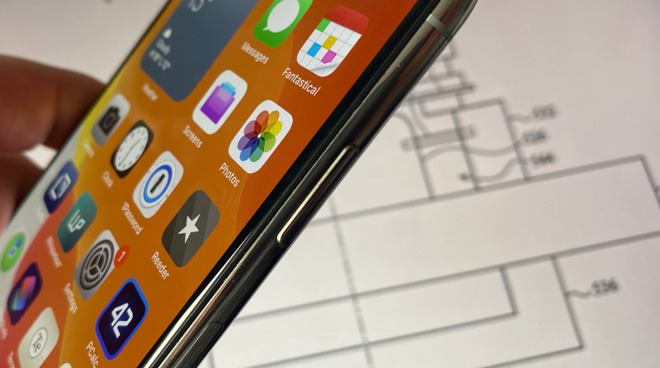Apple is working on technology to make physical buttons such as the iPhone power button or keys on a keyboard thinner, while also adding options for different haptic feedbacks.

Apple wants to make all buttons require less travel, but it does single out the power button on iPhones
Apple is always accused of putting thinness over functionality, but even if it can't always achieve that -- as with the butterfly keyboard -- it's really aiming for both. That now includes how to make physical buttons thinner, but also give them a more responsive touch, including the ability to offer different haptic feedback in different situations.
"Compact pivoting input device," US Patent No, 10,698,489, describes a way of reducing the thickness of a button and how far it has to travel for a press to be registered, by using magnets.
"Mechanical buttons are generally reliable and provide inherent haptic feedback, as a user can often feel the mechanism of the button moving, for example between button positions," says the patent. "However, mechanical switches typically have set haptic outputs or feedback, dictated by their design."
"Also, as electronic devices have become more space-constrained, mechanical buttons have presented problems and design limitations," it continues. "Many mechanical switches need a minimum amount of space to operate. For example, a typical dome switch needs about 200 microns of travel for the dome to collapse and close the switch. This is especially problematic in very thin electronic devices."
While the patent is as ever at pains to cover every conceivable type of button that could be on a device, the first example given is of the power button on an iPhone. That's a single button on its own, rather than in an array like a keyboard, and has one clear function.
You don't need to have haptic feedback when all you're doing is pressing a physical button in once, the mechanical motion gives you the feedback naturally. But it only does so because there is enough movement for your finger to recognize.
Apple proposes a system it calls a compact pivoting input structure, one that may move only slightly -- or possibly not at all. "[This] may allow increased haptic design flexibility and may allow the haptics to change with environmental or use conditions," says the patent.
"Many pivoting buttons travel 10 microns or less when force is exerted thereon," it continues. "Pivoting buttons can use force sensors to determine when the button is pressed, for example. The force sensor registers a change in capacitance, resistance, current, voltage, or other electrical value when the pivoting button moves or flexes, even though such motion may be very small."
Detail from the patent drawings, showing a button that does look rather like a key
To have that existing power button, the iPhone has to have room inside it for the mechanism to operate it. And even though that is already tiny, it could be less -- and Apple believes that brings benefits beyond saving space.
"[A] pivoting system that does not require physical movement may combine several advantages of traditional mechanical switches and pivoting input structures," it says. "For example, a pivoting system devoid of vertical or inward movement may provide the increased reliability of mechanical buttons with the lower profile and variable haptics of a pivoting system."
The entire patent is around 17,000 words, but in summary, the new system for making buttons more compact requires magnets. "An input device includes an input structure, a magnet attached to the input structure, and an electromagnet," explains the patent.
'The magnet rotates when the electromagnet is activated, thereby rotating the input structure," it continues. "The magnet and input structure rotate about a pivot in order to provide haptic and/or visual feedback to a user."
Aside from the example of an iPhone with its power button, practically all of the patent's drawings are close-up diagrams of individual buttons. It's hard to see them, though, without suspecting that this system may also be meant for keyboards.
Apple's patent only says the word "key" three times, and doesn't mention keyboards at all. But it emphasizes that although it chiefly talks about buttons, "the input device may be or include a key, switch, toggle, or the like instead of a button."
The patent lists six inventors, including Michael J. Beyhs, who has previously been credited on a related patent application regarding replacing the Apple Watch's Digital Crown with touch and light sensors.


